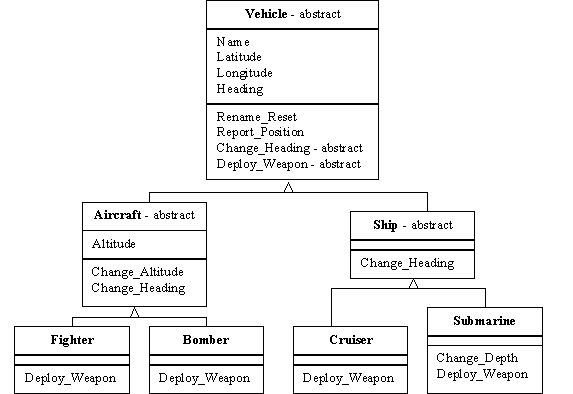5.1 Concepts
and Motivation
[ Table of Contents ] [ Chapter Overview ] [ Next ] [ Glossary/Index ]
Object oriented methods have become very popular during the 1980's and 1990's. Some of
the better known books on this technology are: [Wirfs-Brock90],
[Rumbaugh91], [Coad&Yourdon91], [Jacobson92], [Booch94],
and [Coleman94]. Recent attempts to
"unify" notations and methods have featured the combined efforts of Grady Booch, Ivar
Jacobson and James Rumbaugh. One
result of this collaboration is the Unified Modeling
Language (UML), summarized in [Fowler97].
Central Concepts of Object Technology
- A system is modeled as a collection of interacting objects,
which encapsulate data and which collaborate by sending one another messages.
- Each object is an instance of a general class of objects, which share a common data
structure and a common set of operations upon that data.
- A class may be part of a hierarchy of
classes, such that each descendant class inherits the properties of its parent class and
extends or specializes it.
The elements of Ada covered in earlier chapters can be used to implement object
oriented designs created in the spirit of the three concepts outlined above. In fact, Ada
83 has been used to do so, very successfully, for many years. (An Ada type would represent each class as the term is
used above, ADT packages would be used to declare the types which serve as templates for
the object instances needed, and an Ada derivation
class might represent the "class hierarchy" mentioned above. The "specialization's"
can be handled in various ways, depending on whether new operations or new data structure
are needed.)
The techniques outlined and illustrated in the next several pages provide a more
convenient way to create the class hierarchies and the specialization's. This involves the
second form of derived types
mentioned (but not illustrated) in an earlier chapter. The second form involves a language
feature known as the tagged type
(see next page).
Motivating Example
| This UML class diagram depicts the inheritance relationships for a partial
hierarchy of military vehicles. The root class (it will be "type" in Ada),
Vehicle, has four attributes and four operations common to all descendants. The
Aircraft sub-class adds a new attribute, Altitude, and an associated operation. The
Submarine sub-class of the sub-class, Ship, adds a new attribute, Depth, and an associated
operation. Note that the Aircraft and Ship classes override the operation, Change_Heading,
introduced at the top level, and the four lowest-level classes override the operation,
Deploy_Weapon, introduced at the top level. |

|
Note that each sub-class has an "is a" or "is a kind of"
relationship to its parent -- not an "is part of" or "is a component
of" relationship. Thus, we have a situation where it is appropriate to consider the classification approach rather than the composition approach to OOD and OOP.
Note that the three highest-level classes are labeled as abstract -- meaning that there
is no intention of ever declaring objects of these classes. The low-level classes are
"concrete" and will serve as templates for actual objects. Similarly, two of the
highest-level operations are labeled as abstract, and are "place holders" for
actual operations defined at lower levels. The other two high-level operations,
Rename_Reset and Report_Position, are defined at that level and can be used unmodified in
all descendant classes.
The next section introduces a key language feature, the tagged type. The following sections introduce
additional features and then provide a set of Ada packages that implement the inheritance
hierarchy represented above. Later pages provide example programs in which this set
of packages is used.
Related Topics
[ Back to top of page ] [ Next ]
